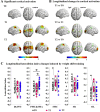Effectiveness of unilateral lower-limb exoskeleton robot on balance and gait recovery and neuroplasticity in patients with subacute stroke: a randomized controlled trial
- PMID: 39639336
- PMCID: PMC11622492
- DOI: 10.1186/s12984-024-01493-9
Effectiveness of unilateral lower-limb exoskeleton robot on balance and gait recovery and neuroplasticity in patients with subacute stroke: a randomized controlled trial
Abstract
Background: Impaired balance and gait in stroke survivors are associated with decreased functional independence. This study aimed to evaluate the effectiveness of unilateral lower-limb exoskeleton robot-assisted overground gait training compared with conventional treatment and to explore the relationship between neuroplastic changes and motor function recovery in subacute stroke patients.
Methods: In this randomized, single-blind clinical trial, 40 patients with subacute stroke were recruited and randomly assigned to either a robot-assisted training (RT) group or a conventional training (CT) group. All outcome measures were assessed at the enrollment baseline (T0), 2nd week (T1) and 4th week (T2) of the treatment. The primary outcome was the between-group difference in the change in the Berg balance scale (BBS) score from baseline to T2. The secondary measures included longitudinal changes in the Fugl-Meyer assessment of the lower limb (FMA-LE), modified Barthel index (mBI), functional ambulation category (FAC), and locomotion assessment with gait analysis. In addition, the cortical activation pattern related to robot-assisted training was measured before and after intervention via functional near-infrared spectroscopy.
Results: A total of 30 patients with complete data were included in this study. Clinical outcomes improved after 4 weeks of training in both groups, with significantly better BBS (F = 6.341, p = 0.018, partial η2 = 0.185), FMA-LE (F = 5.979, p = 0.021, partial η2 = 0.176), FAC (F = 7.692, p = 0.010, partial η2 = 0.216), and mBI scores (F = 7.255, p = 0.042, partial η2 = 0.140) in the RT group than in the CT group. Both groups showed significant improvement in gait speed and stride cadence on the locomotion assessment. Only the RT group presented a significantly increased stride length (F = 4.913, p = 0.015, partial η2 = 0.267), support phase (F = 5.335, p = 0.011, partial η2 = 0.283), and toe-off angle (F = 3.829, p = 0.035, partial η2 = 0.228) on the affected side after the intervention. The RT group also showed increased neural activity response over the ipsilesional motor area and bilateral prefrontal cortex during robot-assisted weight-shift and gait training following 4 weeks of treatment.
Conclusions: Overground gait training with a unilateral exoskeleton robot showed improvements in balance and gait functions, resulting in better gait patterns and increased gait stability for stroke patients. The increased cortical response related to the ipsilesional motor areas and their related functional network is crucial in the rehabilitation of lower limb gait in post-stroke patients.
Keywords: Gait rehabilitation; Neuroplasticity; Stroke; Unilateral lower-limb exoskeleton robot.
© 2024. The Author(s).
Conflict of interest statement
Declarations. Ethics approval and consent to participate: This study was approved by the Medical Ethics Committee of the Third Affiliated Hospital of Sun Yat-sen University ([2021]02-333-01) in accordance with the declaration of Helsinki. All participants gave written informed consent prior to their enrollments. Consent for publication: Not applicable. Competing interests: The authors declare no competing interests.
Figures






References
-
- Jang SH. The recovery of walking in stroke patients: a review. Int J Rehabilitation Res Int Z fur Rehabilitationsforschung Revue Int De recherches de Readaptation. 2010;33(4):285–9. - PubMed
-
- Bang DH, Shin WS. Effects of robot-assisted gait training on spatiotemporal gait parameters and balance in patients with chronic stroke: a randomized controlled pilot trial. NeuroRehabilitation. 2016;38(4):343–9. - PubMed
-
- Stinear CM, Barber PA, Petoe M, Anwar S, Byblow WD. The PREP algorithm predicts potential for upper limb recovery after stroke. Brain. 2012;135(Pt 8):2527–35. - PubMed
-
- Jayaraman A, O’Brien MK, Madhavan S, Mummidisetty CK, Roth HR, Hohl K, Tapp A, Brennan K, Kocherginsky M, Williams KJ, et al. Stride management assist exoskeleton vs functional gait training in stroke: a randomized trial. Neurology. 2019;92(3):e263–73. - PubMed
Publication types
MeSH terms
Grants and funding
- 2023YFC3603703/National Key Research and Development Program of China
- 118009001000160001/Fundamental Research Funds for Central Public Welfare Research Institutes
- 32271370/National Natural Science Foundation of China
- F2022203079/National Natural Science Foundation of Hebei
- SBGJ202001009/Henan Province Medical Key Technologies Research and Development Major Joint Construction Program
LinkOut - more resources
Full Text Sources
Medical

